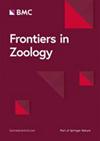猪腹草的动物排列与菌落生长
IF 2.6
2区 生物学
Q1 ZOOLOGY
引用次数: 0
摘要
蓝纽扣,Porpita Porpita (Porpitidae),是一种高度整合的殖民地动物。一个超级有机体。它有多个基因相同的身体(动物),这些身体来自同一个胚胎,它们的功能专门用于不同的任务,并以精确的模式排列。它们的菌落包括浮子、coenosarc、胃虫(摄食息肉)、gonozoids(生殖息肉)和dactylozoids(触手息肉)。殖民地是脆弱的,很难培养,留下了很多关于他们的发展和生命周期未知。利用组织切片和显微ct技术进行形态学观察和组织学分析,为porpita菌落发育提供新的认识。从2019年到2024年,我们收集了267个不同大小的porpita标本来研究群体的发育。形态学研究表明,腹虫、淋虫和趾虫的数量和长度随浮子大小的增加而增加。进一步的组织学切片观察和显微ct技术显示了菌落的内部结构,包括腹虫体、浮体和连接各种虫体的胎腔。未成熟的淋虫和趾形虫在成熟的附近被观察到,为了解它们的群体水平发育提供了线索。此外,一些菌落形状不规则,但仍含有至少一个腹类动物,说明了物种内部的结构差异。我们的研究表明,随着菌落的发展,淋虫和趾虫的数量和大小都在增加。此外,趾形动物的生长区域位于套膜和输卵管的边界,而淋形动物则沿着胃形动物和趾形动物之间的整个上皮生长。菌落的生长通常遵循与菌落周长和面积成正比的模式,有些菌落呈现不规则的形状,表明它们具有很高的再生能力。综上所述,这些发现增强了我们对porpita的生态学和生活史的理解。本文章由计算机程序翻译,如有差异,请以英文原文为准。
Zooid arrangement and colony growth in Porpita porpita
The blue button, Porpita porpita (Porpitidae), is a highly integrated colonial animal—i.e., a superorganism. It has multiple genetically identical bodies (zooids) that arise from the same embryo and are functionally specialized for distinct tasks and arranged in precise patterns. Their colonies include a float, coenosarc, gastrozooid (feeding polyp), gonozooids (reproductive polyps), and dactylozooids (tentacle polyp). Colonies are fragile and difficult to culture, leaving much about their development and lifecycle unknown. We provide new insight into colony development of P. porpita with morphological observation and histological analysis using histological sections and micro-CT technology. From 2019 to 2024, we collected over 267 P. porpita specimens of varying sizes to study colony development. Morphological investigation revealed that the number and length of gastrozooids, gonozooids and dactylozooids increased with float size. Further observation by histological section and micro-CT technique revealed the internal structures of colonies, including gastrozooid, floats, and aboral chambers that connect various zooids. Immature gonozooids and dactylozooids were observed near mature ones, providing insight into their colony level development. In addition, some colonies showed irregular shapes, but still contained at least one gastrozooid, illustrating the structural variation within the species. Our study revealed that gonozooids and dactylozooids increased in both number and size as the colony develops. Moreover, the growth zones for dactylozooids are located at the boundary of the mantle and coenosarc, and gonozooids emerge along the entire epithelium between the gastrozooid and dactylozooids. Colony growth generally follows a pattern proportional to colony circumference and area, and some colonies show irregular shapes, suggesting they have high regenerative capabilities. Taken together, these findings enhance our understanding of the ecology and life history of P. porpita.
求助全文
通过发布文献求助,成功后即可免费获取论文全文。
去求助
来源期刊

Frontiers in Zoology
ZOOLOGY-
CiteScore
4.90
自引率
0.00%
发文量
29
审稿时长
>12 weeks
期刊介绍:
Frontiers in Zoology is an open access, peer-reviewed online journal publishing high quality research articles and reviews on all aspects of animal life.
As a biological discipline, zoology has one of the longest histories. Today it occasionally appears as though, due to the rapid expansion of life sciences, zoology has been replaced by more or less independent sub-disciplines amongst which exchange is often sparse. However, the recent advance of molecular methodology into "classical" fields of biology, and the development of theories that can explain phenomena on different levels of organisation, has led to a re-integration of zoological disciplines promoting a broader than usual approach to zoological questions. Zoology has re-emerged as an integrative discipline encompassing the most diverse aspects of animal life, from the level of the gene to the level of the ecosystem.
Frontiers in Zoology is the first open access journal focusing on zoology as a whole. It aims to represent and re-unite the various disciplines that look at animal life from different perspectives and at providing the basis for a comprehensive understanding of zoological phenomena on all levels of analysis. Frontiers in Zoology provides a unique opportunity to publish high quality research and reviews on zoological issues that will be internationally accessible to any reader at no cost.
The journal was initiated and is supported by the Deutsche Zoologische Gesellschaft, one of the largest national zoological societies with more than a century-long tradition in promoting high-level zoological research.
 求助内容:
求助内容: 应助结果提醒方式:
应助结果提醒方式:


